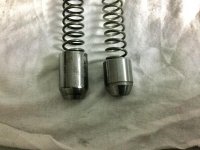D
Deleted member 21878
Guest
Guest
Offline
when i redid my engine i did not replace the valve cap. at the time i was reading a story of someone who had gotten a new one only to have issues. mine looked pretty good so i went with it. i did replace the spring and washer.
recently i have noticed my gauge reads over 60 psi when i first start the engine. this was not the case up until now. it would never go above 60. so i wondered if the head was maybe sticking or something. it is hot and the parts are cheap so i ordered a new head, spring and washer.
put them in and took a ride this morning... early. did i mention it is hot here? seems to be a common theme lately.
anyway when i fired it up this morning, my gauge went up to about 65psi when driving. of course it came down as the engine got hot. now this could be a gauge issue seeing how both valves were reading high. i did check the gauge before with another gauge and it was pretty close. but maybe it has decided to adjust itself a little...
also i noticed the new spring i got this time was about a 1/16" longer than the new spring i got last time. Hmm, both from Moss. maybe the old one compressed some while in use????
none of this may be an issue and i am fine leaving it alone. i really just wondered at what point should i be concerned. i don't think 65 psi is probably a big deal if that is as high as it goes, assuming it is not the gauge. but i wondered what you all think.
while i was changing the valve i did try to clean out the valve seat in case it had something causing it to stick. think i got it pretty good. i certainly did not feel any issues putting in the new head.
Thanks
TL
recently i have noticed my gauge reads over 60 psi when i first start the engine. this was not the case up until now. it would never go above 60. so i wondered if the head was maybe sticking or something. it is hot and the parts are cheap so i ordered a new head, spring and washer.
put them in and took a ride this morning... early. did i mention it is hot here? seems to be a common theme lately.
anyway when i fired it up this morning, my gauge went up to about 65psi when driving. of course it came down as the engine got hot. now this could be a gauge issue seeing how both valves were reading high. i did check the gauge before with another gauge and it was pretty close. but maybe it has decided to adjust itself a little...
also i noticed the new spring i got this time was about a 1/16" longer than the new spring i got last time. Hmm, both from Moss. maybe the old one compressed some while in use????
none of this may be an issue and i am fine leaving it alone. i really just wondered at what point should i be concerned. i don't think 65 psi is probably a big deal if that is as high as it goes, assuming it is not the gauge. but i wondered what you all think.
while i was changing the valve i did try to clean out the valve seat in case it had something causing it to stick. think i got it pretty good. i certainly did not feel any issues putting in the new head.
Thanks
TL

 Hi Guest!
Hi Guest!

 smilie in place of the real @
smilie in place of the real @
 Pretty Please - add it to our Events forum(s) and add to the calendar! >>
Pretty Please - add it to our Events forum(s) and add to the calendar! >> 
